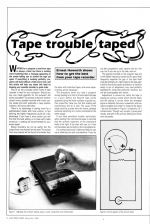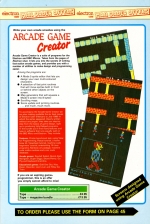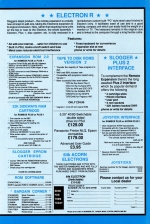

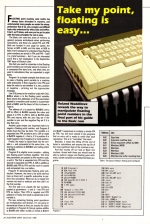
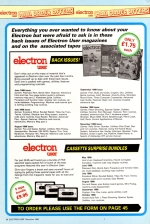

| Genre: | Compilation Of Arcade Games |
| Publisher: | Database |
| Cover Art Language: | English |
| Machine Compatibility: | Acorn Electron |
| Release: | Magazine available via High Street/Mail Order |
| Original Release Date: | 1st December 1988 |
| Original Release Price: | £1.25 |
| Market Valuation: | £1.00 (How Is This Calculated?) |
| Author(s): | - |
Variant Items
There are 0 other items featuring this same game (that we know about!). Click any of them for their details.
Active Auctions
Closed Auctions
Buy It
Unfortunately no-one is currently selling this item.
Auction Price Watch
Worried you're being ripped off? Closing prices on eBay can help you decide what a reasonable price is for a particular item.
Full Instructions
BLOW FOOTBALL
Let your fingers do the blowing in Steve Bissell's adaptation of that popular indoor sport - blow football
 BLOW FOOTBALL is a two player game that usually leaves everybody out of breath. However, if your friend is a bigger windbag than you, don't worry - in this computerised version of the game, the only thing you might have to blow will be your aching fingers.
BLOW FOOTBALL is a two player game that usually leaves everybody out of breath. However, if your friend is a bigger windbag than you, don't worry - in this computerised version of the game, the only thing you might have to blow will be your aching fingers.
The screen shows a bird's eye view of the pitch, with player one going down the screen and player two coming up. The rules are simple - each player has three keys with which he can move the ball. To avoid either player having an unfair advantage, they have been set so they will not auto-repeat.
Holding down a key will not do you any good. Indeed, the only way you can move the ball is to tap the appropriate key as quickly as possible. If no keys are pressed there will be some sideways movement of the ball, due to a slight breeze in the stadium.
The first player to score five goals wins the match. A record of the current scores, along with the total matches won so far, is displayed throughout. At the start of the game you can settle how many matches the game will last, or simply play until one of you gives up with finger fatigue.
All that needs to be done now, is for you to massage your fingers and prepare yourself for some fast and furious action.
Game Controls:
Player 1: Z - Left & Down, X - Right & Down, S - Down
Player 2: > - Left & Down, ? - Right & Up; + - Up
| Variables | |
| X%,Y% | Position of the ball |
| H%,V% | Movement of the ball |
| A%,B% | Temporary position of the ball |
| sc1% | Player 1 score |
| sc2% | Player 2 score |
| t1% | Games won so far player 1 |
| t2% | Games won so far player 2 |
|
Procedures |
|
| instructions | Print instructions |
| screen | Draw the screen |
| score | Update score |
| player | Get players' moves |
| moveball | Move the ball |
| endgame | Game over routine |
Ever dreamed of winning a cool million on the pools? Well, now your chances of making your bank manager grin happly have vastly improved, thanks to this powerful utility designed to predict the draws.
The program's ability to win is as yet untested, but with such a fantastic prize within reach no doubt there will be plenty of eager volunteers willing to try it out. You can bet I will.
First, enter and save the program. When it is run you'll be asked if you want to load a previously saved data file - press N as you haven't created one yet. Next you'll be prompted to enter the details for match number one - the match number is printed in the bottom left hand corner of the screen.
Type in the home team - the first team on the pools coupon - league position, number of home games won and home games lost. You'll find this information on the sport pages of most newspapers. Now do the same for the away team - the second team on the coupon.
When this has been completed the program uses this information to predict the likelihood of the match resulting in a draw. Don't enter anything on the pools coupon at this stage as the data is stored in memory, but continue and enter the details for all the remaining teams. When the program has all the matches in memory press N when it asks you if there is another one, and the match results will be sorted into order of probability of a draw occurring.
The top fifteen matches, along with their rating and coupon number, will be displayed on the screen and all that remains is for you to put your crosses on the coupon. If you are going for the treben chance or full perm, 8 from 11 say, then put crosses against the first eleven matches.
| Procedures | |
| initialise | Dimension arrays, load data file |
| title | Print program title |
| window | Set up a shadowed window |
| input | Input the match data |
| calculate | Work out chances of a draw |
| result | Print match result |
| output | Display 15 most likely draws |
| cls | Clear the screen |
|
Variables |
|
| match% | Match number on the coupon |
| home$ | Home team's name |
| hp | Home team's league position |
| hw | Home games won |
| hl | Home games lost |
| away$ | Away team's name |
| ap | Away team's league position |
| aw | Away games won |
| al | Away games lost |
| draw% | Chances of a draw |
If you press the ESCAPE key, a Save routine will be initiated and the data will be stored on disc or tape before aborting the program. This means you can split the data entry task into more manageable chunks. When the program is run again you can reload the data entered so far and continue where you left off.
The program continues from the match you were entering at the time you pressed ESCAPE, so if you make a mistake, tap the ESCAPE key to save the data, re-run the program to re-load the data and enter the correct match details. It's crude but effective, especially if you have a disc drive.
One point to watch out for is the dreaded Can't Extend error message with the DFS filing system when saving the data. To make sure this doesn't happen, it is always best to use a blank disc on which to save the data. This problem doesn't occur with the ADFS.
The only foreseeable problem with this utility - and every silver cloud has a black lining - is that if every Electron user decides to try their luck and the program does come up trumpts then the payout will be quite small as the money will be split between literally thousands of winners.
Well at least you'll be able to brag that you won the pools!
SANTA'S WORKSHOP
Help Santa collect some last minute presents in Alan Weatherill's game
 SANTA'S WORKSHOP is a game specially written for our younger readers, with a traditional Christmas theme. It's Christmas Eve, and all Santa's helpers have gone home to be with their families. Most of the toys and presents have been put into sacks or safely loaded on to the sleigh, with the exception of a few last minute orders.
SANTA'S WORKSHOP is a game specially written for our younger readers, with a traditional Christmas theme. It's Christmas Eve, and all Santa's helpers have gone home to be with their families. Most of the toys and presents have been put into sacks or safely loaded on to the sleigh, with the exception of a few last minute orders.
It is normally the elves' job to bring the toys and presents to Santa. However, as toyland now has a new work-to-rule contract, came five o'clock it was "High-ho, high-ho, it's home from work we go". Poor old Santa has been left alone in the toy factory, and now must find the last fifty teddy bears and presents left scattered around by the work-shy elves.
The factory looks strange in the evening's dim artificial light. Some weird and not-so-wonderful things have been known to happen after lights-out. Stories of magic crackers and wild unfriendly Christmas puddings have been whispered around the workplace.
Of course, silly rumours are not going to stop our Santa collecting all of the teddy bears and presents - some children will have no Christmas without them. So, with your help to guide Santa around the factory there will be a Christmas for everybody after all, won't they?
When your child has solved the game you may be feeling devious enough to want to set an even harder challenge. Alternatively, if your child keeps getting stuck perhaps a simpler version may be in order. The layout for the screen is taken from the data statements found at lines 3240-3410, and it a simple matter to change these values to ones to suit your needs.
The playing area of the screen is mapped as an 18 x 18 character matrix, and care must be taken to ensure that your design is also of the same dimensions. Also take particular care that each character used is placed in a position that will reflect its purpose in the game. That is to say, there would be no point placing a space at the edge of the screen as you may be able to walk right out of the game.
The table below shows the data numbers used in the program, along with a brief description of each character's purpose:
| No. | Object | Function |
| 0 | Space | A clear corridor for you to walk in |
| 1 | Brick wall | Solid object |
| 2/3 | Santa's sleigh | Solid object |
| 4 | Sack of toys | Solid object |
| 5 | Christmas cracker | If hit, will send you back to the start |
| 6 | Teddy bear | You must collect this |
| 7 | Present | You must collect this |
| 8 | Xmas pudding | If hit, changes into a nasty little creature that duplicates vertically where possible, thus blocking clear passages |
| 9 | Sprite for Santa |
There are fifty toys and presents to collect - remember to include the same total of teddy bears and presents in your own versions. This number can be altered by changing the 50 held in line 2020.
SANTA'S WORKSHOP is a 100 per cent machine code arcade game, written by Alan Weatherill with the aid of the many powerful sprite, map, scrolling and score routines from Roland Waddilove's Sprites series which ran from February to July 1988 in Electron User. These are now available on the Arcade Game Creator tape.
SENET
Arthur Lindon introduces an ancient board game from the Middle East
 SENET is a two-player board game which was popular in ancient Egypt - there is evidence from tombs that it is well over 3000 years old. It was played by all classes. The aristocracy played it on fine boards made of rare woods, ivory and faience (decorated earthenware and porcelain), while the peasants may have played it on nothing more than a board marked out in the sand, or scratched on a stone, using pebbles for counters.
SENET is a two-player board game which was popular in ancient Egypt - there is evidence from tombs that it is well over 3000 years old. It was played by all classes. The aristocracy played it on fine boards made of rare woods, ivory and faience (decorated earthenware and porcelain), while the peasants may have played it on nothing more than a board marked out in the sand, or scratched on a stone, using pebbles for counters.
It is basically a race game for two players - rather like Ludo - and each player tries to move all his counters round the board and on to the last square where they are removed. Each player has five counters, either all red or all blue.
The playing counters move over the track marked out on the board as the ox ploughs - first to the right then to the left and so on. The track squares are labelled A-Z and 1-5 on screen, and you progress through the alphabet and then on to the numbers.
Initially the counters are placed alternately red and blue on the first ten squares. The players' colours are determined by throws of the dice.
| Variables | |
| C%() | The colour of each square |
| N$() | The players' names |
| K% | The counter to move |
| T% | The score on the four dice |
|
Procedures |
|
| PROCthrow | Throw the dice |
| PROCchoice | Read the keyboard |
| PROCmove | Move the counter |
| PROCgo | Main game loop |
| PROCpass | Skip go if Z pressed |
| PROCpause | A short delay |
To start the game, the players each throw the dice until one of them throws a one. This player has the square blue counters, and the other has the round red ones. The blue counter on square J is automatically moved to square K, and after the first move blue continues to throw the dice.
If he throws one, four or six he can move any of his counters the indicated number along the track then throw again. If he throws a two or three he moves a counter the indicated number of squares and play passes to the other player.
The second player (red) must make his first move from square 1, or if the counter on that square has been moved by blue, from the next lower square containing a red counter, but with subsequent throws of the dice may move any of his playing counters. Each turn ends with a throw of two or three.
Two counters cannot occupy the same square and if one lands on a square occupied by an opponent's counter the latter is said to be under attack and is moved back to the square just vacated by the counter in play. In other word, they are exchanged.
If two counters of the same colour occupy consecutive squares they protect each other and cannot be attacked. Three counters of the same colour on consecutive squares form a protected blockade, and they can neither be attacked nor passed by enemy counters. However, they don't block the passage of counters of the same colour.
The five numbered squares at the end of the track have special significance. Square two marked with an X is a trap. Any counter which lands here must return to the first vacant square on the board and begin the journey again. Squares one, three and four - marked with hieroglyphics - are haves where counters are not vulnerable to attack.
If it is impossible to move any man forward the turn ceases. Pressing Z will pass the turn on to the other player unless there is a counter that could be moved, but would fall into the trap (X). Such cheating will not succeed, and the counter will be moved back to the start in the normal trap sequence.
When a player has moved all his counters into the last (exit) row, he may take them off by landing them exactly on the last square numbered five. If any of the counters on the exit row are attacked or thrown back to the first or second row, the counters of the same colour which remain on the board may not be taken off until the lagging counter returns to the third row.
The player who first moves all his counters off the board is a winner.
It sounds a very complex game, but surprisingly, is quite easy to learn. If you're not sure which counter to move try pressing any of the keys with one of your counters on. The game is well error-trapped and won't let you make a wrong move.
The number of squares you can move a counter is determined by throws of four two-sided dice, and these are unusual. One side is read and the other white and the scores produced are as follows:
| One white side up | 1 |
| Two white sides up | 2 |
| Three white sides up | 3 |
| Four white sides up | 4 |
| Four red sides up | 6 |
The probabilities of these scores occurring are four, six, four, one and one respectively, out of 16 throws. This has been verified by practical experiment to be very accurate over a large number but, of course, may not appear so over a small quantity.
In a nutshell, move your counters round the board to the number five square. You can land on an opponent's counter on its own, but not if there are two or three in a row. You can jump over any counters in the way, except when your opponent has three in a row.
Screen Designers
The following utilities are also available to allow you to edit the supplied screens of this game:
Cheats
Download
A digital version of this item can be downloaded right here at Everygamegoing (All our downloads are in .zip format).
| Download | What It Contains |
|---|---|
| A digital version of Electron User 6.03 suitable for Elkulator 1.0 (PC (Windows)) | |
| A digital version of Electron User 6.03 suitable for Elkulator 1.0 (PC (Windows)) |
Magazine Articles (29)
Linked articles are available to view in full on this site.
Magazine Adverts (30)
Linked adverts are available to view in full on this site.
Magazine Reviews (3)
Linked reviews are available to view in full on this site.
Technically it's all fine with neat, fast graphics and it has pleasing sound effects but it lacks any kind of extra feature to make it stand out from the crowd.
Magazine Type-Ins (5)
Linked articles are available to view in full on this site.
Magazine Scans (56)
Report A Problem
We thank you from the bottom of our hearts if you report something wrong on our site. It's the only way we can fix any problems!
You are not currently logged in so your report will be anonymous.
Add Note
Release Country
Change the country to update it. Click outside of this pop-up to cancel.
Scan Of Selected Article
If you auction an item, it will no longer show in the regular shop section of the site.















